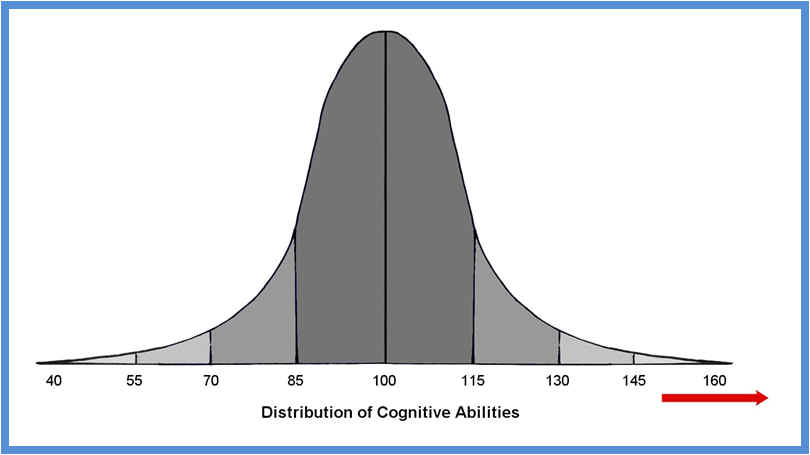
Statistical
information from Guiding the Gifted Child, 2002.
§
The mean, or average, IQ is 100. Standard deviations,
in most cases, are 15 points.
§
The majority of the population, 68.26%, falls within
one standard deviation of the mean (IQ 85-115).
This is the intellectual ability range addressed by the standard school
age/grade-based curriculum.
§
13.59% of the population is between the first and second standard
deviation below the mean (IQ 70-85), and 13.59% is between the first and second
standard deviation above the mean (IQ 115-130).
Students on both sides of the curve
require a modification to the curriculum from that provided to mainstream
students to address their needs.
§
2.14% of the population is between the second and third standard
deviation below the mean (IQ 55-70), and 2.14% is between the second and third standard
deviation above the mean (IQ 130-145).
These exceptional students on both
sides of the curve require an individualized curriculum to address their
individual needs.
§
0.13% of the population is more than three standard
deviations below the mean (IQ <55), and 0.13% of the population is more
than three standard deviations above the mean (IQ 145-160). Thus, 13 out of 10,000 individuals score above 145 and are considered profoundly gifted.
These students on both sides of the
curve are very exceptional and require individualized accommodations to
address their needs.
§
Approximately, one out of 30,000 individuals (.003%) is more than
four standard deviations above the mean (IQ >160).
These students with an IQ of 160
and above require extremely exceptional educational accommodations to meet
their needs.
Policies
& Practices
In 2015, the
Elementary and Secondary Education Act (ESEA) was revised and
reauthorized as the Every Student Succeeds Act (ESSA), which now
includes several provisions to support gifted students. The ESSA/ESEA
signifies the first time that the U.S. Congress makes clear Title I
funds may be used to identify and serve gifted students. It also
requires states and school districts to specify how they will use such
funds to train teachers to identify and meet these students’ academic
needs. This legislation replaces No Child Left Behind and effectively
shifts the bulk of involvement and authority in public schools from the
federal government to states and local school districts.
(Read more about the ESEA provisions for gifted students on the
National Association for Gifted Children's website
here.)
Established in 1988 and reauthorized in the
2015 Every Student Succeeds Act (ESSA), the
Jacob Javits
Gifted Education Program remains the only federal program focused on
gifted education, with $12 million included in the Fiscal Year 2017 budget. The Javits program funds applied or classroom-based research to
help develop effective strategies for identifying and serving
high-potential students from populations that have historically been
underrepresented in gifted education. This Javits-funded research has
yielded valid and reliable ways to identify gifted students from
underserved populations, fair and equitable observation tools for
identifying gifted and talented English Language Learners and strategies
to help teachers improve the academic performances of high-potential
black and Hispanic students as well as those with disabilities and from
low-income families.
At the state policy level, many states have no laws
mandating gifted education and, of those with mandates, many have no
available funding for gifted education. Thus, gifted education practices can
vary by district and by school. For a current list of state policies and
funding, visit the
Davidson State Policy Database.
###
|